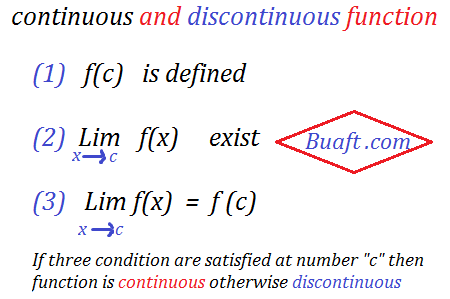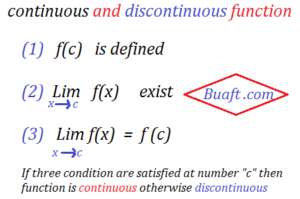Continuous and discontinuous function:A function f is said to be continuous at a number “c” if and only if the following three cases are satisfied:
Discontinuous function:
If one or more of these three condition are fail to hold at “c” then function is said to be discontinuous function.
Continuous and discontinuous Function:
Example:
Consider the function:
f(x) = x ² – 1 / x-1
or
(x -1)(x + 1) /x -1)
because
a ² – b ² = (a – b) (a + b)
Solution:
Here, f(1) is not defined
⇒ f(x) is discontinuous at 1.
Further
Therefore, f(x) is continuous at any other number whose x ≠ 1.
Continuous function example:
For f(x) = 3x² – 5x + 4
discuss continuity of “f”
at x = 1
SOLUTION:
And
Therefore
f(x) is continuous at x = 1:
Discontinuous Function Example:
discuss the continuity of f
at x =3
f(x) = x-1, if x < 3
f(x) = 2x + 1, if 3 ≤ 1
Solution:
from the graph, we see that there is a break in the figure at the point when x = 3
Now f(3) = 2(3) + 1 =7
this implies that(⇒) condition (i) is satisfied
That is, condition (ii) is not satisfied
Hence, f(x) is not continuous at x = 3
RELATED POST
- Limit of a function concept
- ♣
- Left-hand limit and right-hand limit
- ♣
- Relations concept example in math
- ♣
- Straight Line parallel to the x-axis equation
- ♣
- multiplicative property of inequalities
- ♣
- Additive identity of a matrix example
- ♣
- Type of surd or irrational root definition and example
- ♣
- standard equation of parabola proof

